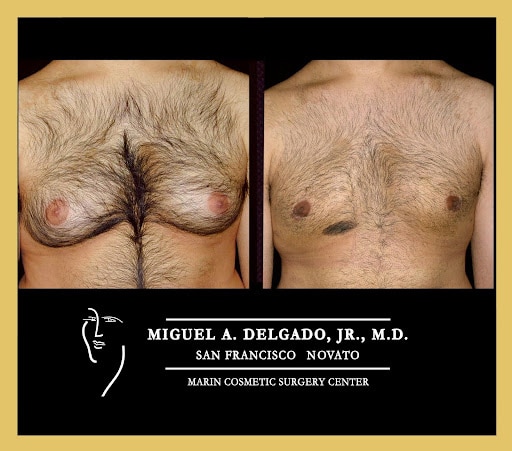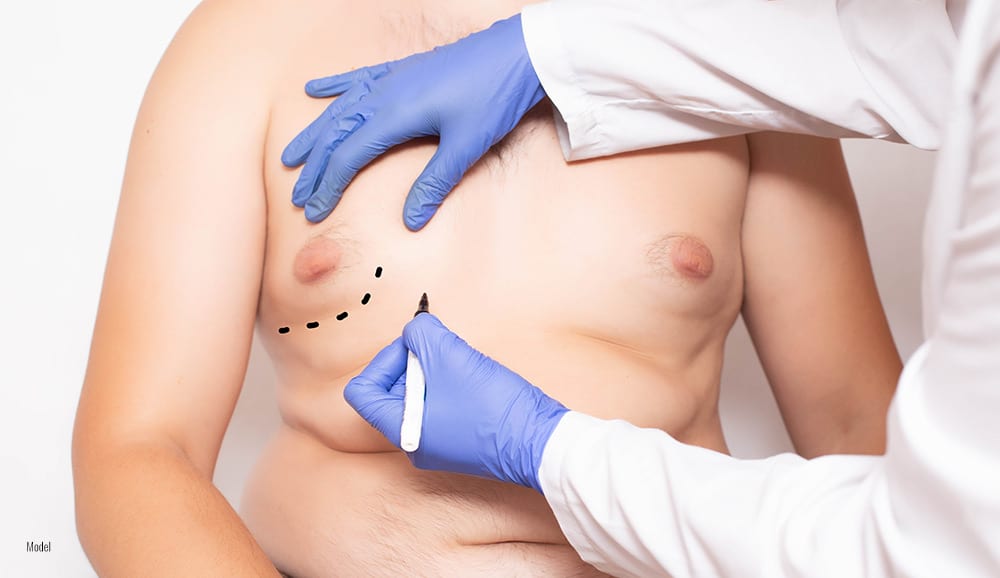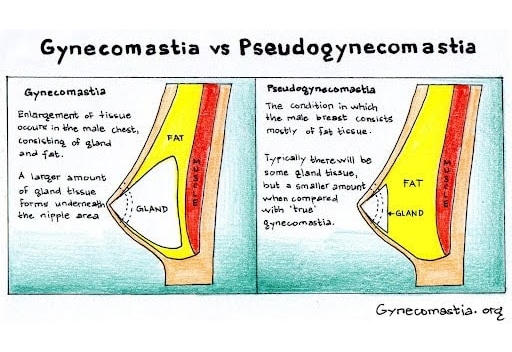
If you’re planning gynecomastia surgery, this is a complete guide for your journey. We’ll discuss each step: understanding the condition, preparing for your consultation, pre-surgical tips, what happens on surgery day, and the complete recovery process. This guide ensures you know what to expect and how to prepare for a successful outcome.
Key Takeaways
- Gynecomastia results from hormonal imbalances or other medical conditions, leading to enlarged male breasts, which can negatively impact physical and psychological well-being.
- Adequate preparation for gynecomastia surgery involves choosing a skilled surgeon, comprehending the surgical methods, and adhering to pre-surgery health optimization guidelines.
- Long-term recovery after surgery is critical, involving follow-up care, maintaining a healthy lifestyle, and managing expectations regarding healing and final results over several months.
Understanding Gynecomastia

Patient of Dr Delgado with before and after gynecomastia surgery at 4 months.
Enlarged male breasts, known as gynecomastia, result from an atypical proliferation of breast tissue in men. Factors such as hormonal imbalances, certain medications, and underlying health issues like liver or kidney disease can trigger this condition. Pinpointing the exact cause is crucial to crafting a tailored and effective treatment strategy for managing the growth of enlarged breast tissue.
It’s essential to differentiate between genuine gynecomastia, which involves an increase in glandular breast tissue, and pseudogynecomastia, where enlargement occurs due to excess fatty deposits. Both lead to a comparable appearance, but have distinct origins, requiring separate approaches for management. Common indicators of gynecomastia include sensitivity and discomfort within the breast area, which may impede regular activities and quality of life.
It is also important to note that while gynecomastia can slightly elevate the risk of male breast cancer, the actual likelihood of men developing this disease remains very low.
The impact of huge breasts extends beyond physical discomfort. It also includes significant psychological challenges. The embarrassment associated with possessing male breasts often undermines confidence levels, creating hurdles in social participation and self-perception. Male breast reduction surgery offers a means not only to improve one’s outward appearance, but also profound benefits for mental health by elevating emotional states and boosting self-assurance.
What is Gynecomastia?
Gynecomastia is a medical condition marked by the abnormal enlargement of breast tissue in males, commonly referred to as male breast enlargement or “man boobs.” This condition can affect one or both breasts and is typically caused by an imbalance of hormones, specifically estrogen and testosterone. When estrogen levels (which promote breast tissue growth) are higher relative to testosterone, it can lead to the development of gynecomastia.
This condition can be embarrassing and distressing for men, significantly impacting their self-confidence and quality of life. Gynecomastia can be classified into different grades, ranging from mild to severe, and can be effectively treated with male breast reduction surgery. Understanding the underlying causes and seeking appropriate treatment can help men regain confidence and improve their physical appearance.
Types of Gynecomastia
Gynecomastia can be divided into two main types: true gynecomastia and pseudo-gynecomastia. True gynecomastia is characterized by the growth of glandular tissue, the actual breast tissue. Hormonal imbalances, certain medications, or underlying health conditions often cause this type. On the other hand, pseudo-gynecomastia is caused by excess fat in the breast area, usually associated with weight gain or obesity.
Gynecomastia can also be classified into different grades based on the severity of the condition:
- Grade 1: Slight enlargement of breast tissue with no excess skin.
- Grade 2: Mild to moderate increase in breast size with or without excess skin.
- Grade 3: Moderate to substantial increase in breast size with excess skin.
- Grade 4: Significant enlargement with considerable loose skin, resembling drooping female breasts.
Understanding the type and grade of gynecomastia is crucial for determining the most effective treatment approach, whether it involves surgical intervention or lifestyle changes.
Benefits of Gynecomastia Surgery

Plastic surgeon marks gynecomastia area
Gynecomastia surgery, also known as male breast reduction surgery, offers numerous benefits for men struggling with enlarged breast tissue. This surgical procedure can significantly improve both physical appearance and psychological well-being. Some key benefits include:
- Improved Chest Contour: Gynecomastia surgery removes excess breast and glandular tissue, helping achieve a flatter, more traditionally masculine chest shape.
- Enhanced Self-Confidence: Many men experience a boost in self-esteem and confidence after surgery, as they no longer feel self-conscious about their chest appearance.
- Reduced Risk of Skin Irritation: Excess breast tissue can cause skin irritation and discomfort, which can be alleviated through surgery.
- Permanent Solution: Gynecomastia surgery provides a long-lasting solution to the condition, allowing men to enjoy the results for years.
- Customizable Treatment: The surgery can be tailored to meet individual needs and goals, ensuring optimal results for each patient.
Addressing both the physical and emotional components of gynecomastia, male breast reduction surgery can greatly enhance one’s quality of life.
Improved Chest Contour and Reduced Risk of Breast Cancer
One of the primary benefits of gynecomastia surgery is improving chest contour. The surgery helps men achieve a masculine chest shape by removing excess breast and glandular tissue. This not only enhances physical appearance, but also boosts self-confidence and self-esteem.
Additionally, gynecomastia surgery can reduce the risk of breast cancer. Men with gynecomastia have a higher risk of developing breast cancer due to excess breast tissue. The surgery lowers the risk by removing this tissue, providing long-term health benefits. This dual advantage of improved aesthetics and reduced cancer risk makes gynecomastia surgery a valuable option for men dealing with this condition.
Choosing a Qualified Cosmetic Surgeon
Selecting a qualified cosmetic surgeon is crucial for achieving the best results from gynecomastia surgery. A skilled and experienced surgeon can help men achieve their desired chest contour while minimizing the risk of complications. When choosing a surgeon, one must consider their qualifications, experience, and reputation.
Why Choose a Board-Certified Surgeon?
Opting for a board-certified surgeon ensures you are in the hands of a professional with extensive training and expertise to perform gynecomastia surgery safely and effectively. Board-certified surgeons have passed rigorous exams and demonstrated their knowledge and skills in plastic surgery. This certification is a testament to their commitment to maintaining high care and patient safety standards.
By choosing a board-certified surgeon, men can feel confident that they will receive the best possible care and achieve their desired results. A qualified surgeon can help men attain a more masculine chest shape, reduce their risk of breast cancer, and improve their quality of life.
What to Expect During Consultation with a Healthcare Provider
During your consultation with a healthcare provider, you can expect a thorough discussion about your gynecomastia condition, medical history, and treatment options. Your provider will examine your breasts, measure your breast tissue, and screen you for male breast cancer. They will also discuss your goals and expectations from the surgery, and the potential risks and complications.
Your provider may ask questions about your medical history, including any previous surgeries, allergies, and current medications. They may also inquire about your lifestyle habits, such as smoking and exercise, to determine the best treatment for you.
It is essential to be open and honest with your provider about your concerns and expectations.This transparency helps them develop a tailored treatment plan that caters to your specific needs and objectives.
Some questions to ask your provider during the consultation include:
- What are the causes of my gynecomastia?
- What treatment options are available to me?
- What are the risks and complications associated with gynecomastia surgery?
- How long will the recovery process take?
- What are the expected results of the surgery?
- Are there alternative treatments available?
Asking these questions can help you better understand your condition and treatment options. This will help you make an informed decision about your care and ensure you receive the best possible results from your surgery.
Preparing for Your Consultation

Illustration of a patient preparing for gynecomastia surgery with pre-surgery instructions.
Preparing for your gynecomastia consultation is essential for a more contoured, masculine chest appearance. During this appointment, you’ll review your medical history and present health conditions with the surgeon to ensure you’re in optimal shape before surgery. This conversation helps address any pre-existing issues, so you are as prepared as possible for the upcoming procedure. Your provider may recommend a complete blood count (CBC) or other tests to evaluate your health before surgery.
It’s essential to ask which surgical techniques will be used, and understand why they have been selected for your case. Comprehending how the surgery will be performed allows you to form realistic expectations and become familiar with each aspect of your tailored treatment plan. It’s also key to discuss what potential complications could arise and their management strategies. Being informed beforehand about signs of trouble contributes significantly to mitigating worry and paves the way for a smoother recovery process.
Ensuring you choose a board-certified surgeon proficient in handling gynecomastia surgeries is critical for achieving top-notch results. Trusting someone like Dr. Miguel Delgado, recognized for his expertise and reputable practices, guarantees high-quality care throughout your experience while safeguarding against complications during surgery execution. Strong groundwork via comprehensive preparation bolsters the chances of successful surgical outcomes and enriching experiences.
Tips for Pre-Surgery Preparation
Before undergoing gynecomastia surgery, it’s essential to minimize potential risks and facilitate a smoother recovery by adequately preparing. This preparation involves discontinuing the use of certain medications that can interfere with surgical outcomes, such as blood thinners and recreational drugs. Smoking cessation is critical at least six weeks before the procedure for improved healing and decreased complications.
It’s essential to be in good physical and mental shape before any type of plastic surgery, including male breast reduction. To achieve this state of health, stay physically active, maintain a nutritious diet, and manage any existing chronic conditions effectively. Taking care of your overall health will help strengthen your body’s capacity for rapid and efficient post-operative recovery.
For practical considerations leading up to cosmetic surgery, like male breast reduction as an outpatient procedure: ensure transportation arrangements are made for returning home after the operation, plan for someone who can assist you during early recuperation, opt for loose-fitting attire on the day scheduled for surgery—this practice helps reduce discomfort while facilitating more straightforward access to post-surgical dressings or maintenance needs. These organized steps enable you to concentrate on resting comfortably throughout recovery, without facing undue stress or setbacks due to unanticipated issues.
Surgery Day Preparation
On the day of your gynecomastia surgery, you must be well-prepared to ensure a smooth and successful procedure. Here are some tips to help you prepare:
- Arrive at the surgical center or hospital at the designated time, usually 1-2 hours before the scheduled surgery.
- Wear loose-fitting clothing that is easy to remove and put back on, such as a button-down shirt or a zip-up jacket.
- Remove any jewelry, glasses, or contact lenses before the surgery.
- Do not eat or drink anything for at least 8 hours before the surgery, unless your provider instructs you otherwise.
- Bring a friend or family member to drive you home after the surgery and stay with you for the first 24 hours.
- Bring any necessary medications, such as pain relievers or antibiotics, as instructed by your provider.
- Bring a compression garment or vest after the surgery, as instructed by your provider.
By following these tips, you can ensure that you are well-prepared for your surgery and can focus on your recovery.
Techniques for Male Breast Reduction Surgery
Several surgical methods are available to address gynecomastia, tailored to the condition’s severity and unique aspects. The primary approaches include liposuction to remove excess fatty tissue and excision to eliminate glandular breast tissue and any surplus skin. Utilizing a combination of these procedures facilitates a thorough male breast reduction.
The strategy for treatment depends on the grade of gynecomastia present. In instances of Grade 1, typically, just gland excision coupled with liposuction will suffice to achieve the desired outcomes. For patients experiencing Grade 2 gynecomastia, direct gland removal and liposuction are necessary due to both glandular and fatty tissues involved. Those suffering from more intense manifestations, such as Grade 3, may need an initial removal followed by liposuction, potentially via two separate operations. Treatment of Grade 4 requires a double incision mastectomy, accompanied by free-nipple grafting, due to considerable excess tissue and skin present.
Strategic placement of incisions during surgery is vital for minimizing visible scars later on. Incisions are commonly made around the areola or within natural creases on the skin. Their size dictates how much extra material must be removed.
Liposuction can be used alone to remove excess fat in gynecomastia surgery. This is effective with pseudogynecomastia. However, liposuction does not remove breast tissue. Liposuction involves inserting a suction hose through small incisions to remove fat.
Donning a compression vest post-surgery reduces swelling and provides support as your chest adapts to its new shape. Wearing a compression vest for several weeks post-surgery is recommended to achieve optimal recovery and results. Following this protocol, alongside selecting a board-certified plastic surgeon who specializes in treating gynecomastia, can significantly improve results while decreasing potential complications like scarring or psychological distress associated with surgery recovery.
Day of Surgery: What to Expect
Upon your arrival for the gynecomastia surgery, it is recommended that you wear clothing that is easy to put on and take off due to its loose fit. This will contribute to a comfortable experience during and after the surgical procedure. To ensure you remain asleep without discomfort or pain throughout the operation, you’ll be administered either intravenous sedation or general anesthesia, which also serves to mitigate potential anxiety, ensuring utmost comfort.
The duration of this surgical procedure usually spans between one and two hours, where incisions near the nipples are made to eliminate unwanted glandular tissue as well as surplus skin. The precise methods employed during your surgery depend on how severe your case is and how much tissue requires extraction. Post-operation, while recovering before being released on that day, close observation will be provided, along with medications designed for pain control. Bandages, together with supportive attire, shall assist in early recuperative phases.
Understanding what unfolds on surgery day may dispel trepidations or doubts about it. Adherence to guidelines from healthcare providers regarding preparation for and recovery from surgery paves the way towards an incident-free outcome following gynecomastia correction procedures.
Initial Recovery Phase

An image representing the initial recovery phase after gynecomastia surgery at 3 weeks.
The beginning of the recovery period is pivotal in shaping the recovery journey. It’s essential to have a clear understanding of anticipated pain levels and establish an effective pain management strategy for post-surgery comfort. Typical side effects can include sensations such as pain, numbness, sensitivity, and potential nausea following surgery. To address these issues, patients are usually prescribed analgesics or may use over-the-counter alternatives like Tylenol.
During this vital phase, just after surgery, wearing compression garments is essential—they should be used consistently for at least a fortnight to reduce swelling and strengthen the healing process. Sleeping on your back at a 45-degree angle during the initial week is recommended to avoid pressure on the surgical site. Patients must also refrain from vigorous exercise or intense physical activities during the first four weeks post-operation to prevent complications and ensure efficient recovery. Engaging in gentle walking can enhance circulation and lower the chance of developing blood clots.
Employing ice packs throughout early convalescence helps significantly manage inflammation. Applying them intermittently—for periods like 15 minutes—can effectively alleviate discomfort and swelling. Once sufficiently healed, massaging the scar tissue around the breasts can help soften the tissue and potentially reduce scarring and contour irregularities. In those initial days post-surgery, when peak soreness and swelling are expected components of recovery timeframes, adhering to these protocols above will significantly help achieve a smoother transition through this critical stage of rehabilitation.
Effective Recovery Strategies

Post-Op compression garment.
Recovering from gynecomastia surgery requires patience, rest, and proper care. Here are some effective recovery strategies to help you heal quickly and minimize complications:
- Follow your provider’s instructions: Your provider will give you specific instructions on how to care for yourself after the surgery. Follow these instructions carefully to ensure a smooth recovery.
- Rest: Rest is essential for your body to heal. Refrain from engaging in strenuous activities, such as heavy lifting, bending, or exercising, for a minimum of 2-3 weeks following the surgery.
- Pain management: Your provider will prescribe medication to help manage discomfort or pain after the surgery. Take the medication as directed, and do not exceed the recommended dosage.
- Compression garments: As instructed by your provider, wear a compression garment or vest to help reduce swelling and promote healing.
- Follow-up care: Attend all follow-up appointments with your provider to ensure you are healing correctly and address any concerns or complications.
By following these recovery strategies, you can ensure a smooth and successful recovery from your gynecomastia surgery.
Gynecomastia Recovery Timeline
The recovery timeline for gynecomastia surgery varies from person to person, but here is a general outline of what you can expect:
- Immediate recovery (0-2 weeks): After the surgery, you will experience swelling, bruising, and discomfort. Your provider will prescribe pain medication to help manage any discomfort.
- Early recovery (2-4 weeks): You will start to feel better and gradually return to your normal activities. You may still experience some swelling and bruising, but this should begin to subside.
- Intermediate recovery (4-6 weeks): You will start to see the final results of the surgery, and any swelling or bruising should have subsided. You can gradually return to strenuous activities like exercise or heavy lifting.
- Final recovery (6-12 weeks): You will fully recover from the surgery; any scars should have faded. You can resume all normal activities, including exercise and heavy lifting.
Remember that everyone’s recovery timeline is different, and your provider may give you specific instructions based on your individual needs and circumstances.
Returning to Normal Activities
After undergoing gynecomastia surgery, a patient must exercise patience and follow the guidance provided by healthcare professionals closely. Men can resume light daily activities and desk-based work within seven days following their procedure. Those engaged in jobs that require heavy lifting or intense physical labor should take at least one more week off before returning to such tasks to mitigate any risk of complications during this delicate phase.
Typically, patients can consider vigorous physical activity again around four to six weeks post-surgery. Throughout these initial weeks, it’s crucial not to partake in strenuous workouts that could jeopardize the chest area’s recovery. To facilitate healing and help shape the newly sculpted chest contour, wearing a compression garment for up to six weeks after surgery is often recommended. A noticeable enhancement in the appearance of their chest typically becomes apparent between four and six weeks after surgery. An improvement commonly serves as positive reinforcement for self-esteem.
Adhering strictly to prescribed advice, while cautiously escalating levels of exertion, will contribute significantly to securing a safe and efficient healing journey. During this critical recovery timeline, paying attention to one’s body signals without overexerting oneself is pivotal for successful recuperation from gynecomastia surgery.
Long-Term Gynecomastia Surgery Recovery and Results

Before: Patient of Dr. Delgado with adolescent gynecomastia and grade 2.
After: An illustration showing the long-term results of gynecomastia surgery and recovery.
Recovering from gynecomastia surgery requires continued vigilance and care to achieve optimal results. It’s critical to keep all scheduled post-operative check-ups, so your surgeon can track the healing process and resolve any complications that arise after the procedure, modifying your recuperation protocol as necessary.
The journey to full recovery following a gynecomastia operation spans between 6 and 12 months. You’ll likely notice most swelling subside by six weeks. Understanding the typical gynecomastia surgery recovery timeline and following medical advice can help alleviate concerns and ensure the best possible results post-surgery. To preserve the enduring benefits of the surgery, regular physical activity, maintaining a nutritious diet, and steering clear of factors known for disrupting hormonal balance is crucial.
Employing state-of-the-art surgical methods helps reduce visible scarring. Although there may be temporary alterations in nipple sensation after surgery, these are typically not permanent. By strictly adhering to post-surgery instructions provided by your surgeon and health-conscious lifestyle choices, you can ensure lasting satisfaction with your gynecomastia surgery outcomes.
Managing Enlarged Breasts and Extra Breast Tissue
Managing enlarged breasts and extra breast tissue requires self-care, lifestyle changes, and medical treatment. Here are some tips to help you manage your condition:
- Wear a compression garment: Wearing a compression garment or vest can help reduce swelling and promote healing.
- Exercise regularly: Regular exercise, such as cardio and strength training, can help reduce breast tissue and improve overall health.
- Maintain a healthy weight: Maintaining a healthy weight through a balanced diet and regular exercise can help reduce breast tissue and improve overall health.
- Avoid certain medications: Certain medications, such as steroids and hormones, can contribute to gynecomastia. Avoid taking these medications unless necessary.
- Consider surgery: If your gynecomastia is severe or persistent, you may want to consider surgery to remove excess breast tissue.
Following these tips, you can manage your enlarged breasts and extra breast tissue and improve your overall health and well-being.
Dr. Miguel Delgado’s Expertise
Recognized as an expert in male breast reduction, Dr. Miguel Delgado holds board certification as a plastic surgeon. He has been honored by multiple San Francisco publications as one of the city’s top doctors. His skill and knowledge in performing gynecomastia surgery make him a reputable healthcare provider for those seeking effective treatment.
Dr. Delgado stands out in gynecomastia care due to his pioneering techniques and dedication to maintaining stringent safety protocols during surgeries, earning him prominence in this specialized area. He has also gained media attention for his work, with appearances on outlets such as the BBC and Fox News that showcase his influence on advancements in treating this condition.
Beyond honing his craft surgically, Dr. Delgado dedicates time to humanitarian efforts by offering medical services in economically disadvantaged areas across Central America. He serves Gynecomastia.org as its medical director, supporting fellow professionals and patients, ensuring access to superior standards of care within this field.
Summary
In summary, the surgical procedure for gynecomastia offers a highly effective solution for males with enlarged breasts. To secure optimal results, it is critical to be informed about the illness, thoroughly prepare for your consultation, and attentively follow through with each stage of the recovery process. The proficiency offered by an accomplished surgeon, such as Dr. Miguel Delgado, can substantially enhance your experience during surgery and your satisfaction with its outcome.
Adhering to this guide’s instructions enables you to undertake gynecomastia surgery with assurance and clear expectations. Remember that attaining a flatter, more traditionally masculine chest involves several steps. Thorough preparation and diligent post-operative care pave the way towards enduring improvements in appearance and self-confidence. Embark on this transformative journey by arranging a consultation today with a board-certified plastic surgeon, who will help evaluate your treatment options.
Frequently Asked Questions
How long does swelling last after gynecomastia surgery?
Swelling after gynecomastia surgery can last from a few days to several weeks, depending on individual circumstances and the extent of the procedure. It is essential to follow post-operative care instructions to help with a quicker recovery.
When can I return to work after gynecomastia surgery?
You can return to light activities and office work within a week after gynecomastia surgery. Following your surgeon’s specific recommendations for a safe recovery is crucial.
What activities should I avoid post-surgery?
To prevent complications, avoiding heavy physical activities and vigorous exercise for at least three weeks after surgery is crucial. Adhering to this guideline will help you recover.
How long does it take to see the final results of gynecomastia surgery?
The final results of gynecomastia surgery typically become evident between two weeks and three months after the surgery as the swelling subsides. Therefore, patience is essential during the recovery process.
Is it safe to resume sexual activities after gynecomastia surgery?
It is generally safe to resume sexual activities two to three weeks after gynecomastia surgery. However, it is advisable to consult your surgeon for personalized guidance.




